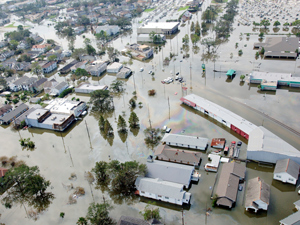
(FinalCall.com) – When analyzing the six year impact of Hurricane Katrina, some researchers believe it is impossible to understand what happened and what still lingers without considering race, gender, and poverty.
“It will probably take a decade or two for the city to fully recover. A lot of people who have returned are interested in putting the lessons of Katrina behind them, which is a huge mistake in my opinion. Katrina showed a lot about our city in terms of race and class. We have problems engrained in this city,” Bill Quigley told The Final Call.
Mr. Quigley is a professor at Loyola University New Orleans, College of Law, and the associate director of the Center for Constitutional Rights. Along with Loyola professor Davida Finger, they released the annual 2011 Katrina Pain Index report on Aug. 22.
“As a whole, we did not do a very good job of protecting and welcoming back our most vulnerable population which included the elderly, children, and renters. Tens of thousands didn’t make it back,” says Mr. Quigley.
According to their report, the city’s population is Whiter and about 110,000 less than when Katrina and subsequent flooding struck in 2005. In the New Orleans metropolitan area, there are now 65,423 fewer Black women and overall the number of women and girls has decreased by 108,116.
Over 3,000 public housing apartments occupied by Blacks before Katrina were bulldozed after the storm.Only half of the 3,000 families have even made it back to the city at all, the report states.
“We still have deep racism. We still have communities that won’t get attention until something bad happens. They deserve the same human rights and dignity as other communities. We have to make the system work for everybody,” says Mr. Quigley.
The report further notes that the homeless population has increased by 70 percent and 34 percent of children live in poverty. An increase in heart attacks was documented in the two years after the storm in New Orleans.
The federal, state and local governments are still being criticized for negligence and slow responses during and after the flooding. Two years after Katrina, reports came forth that U.S. officials turned down numerous offers of aid from foreign allies totaling more than $1.2 billion.
A 2008 post-Katrina study by the Institute for Southern Studies exposed America’s violations of human rights, disregard for UN relief standards, weak disaster laws and refusal to implement disaster policies at home that it imposes on foreign nations.
FEMA was widely condemned for its red tape and was later exposed in giving away approximately $85 million in household goods intended for hurricane victims. FEMA trailers turned out to be a formaldehyde nightmare, causing severe illnesses.
The Pain Index report says FEMA is now reviewing the grants it gave to 154,000 people following hurricanes Katrina, Rita, and Wilma. FEMA’s error rate following Katrina was 14.5 percent.
Mr. Quigley believes that President Obama’s administration has made some positive efforts but warns that it is the system that needs a complete overhaul.
“The recent developments with the NOPD Katrina-related charges and the funds being released to people from the Road Home program would have never taken place under a Republican administration,” says Mr. Quigley. “Maybe our expectations of him (Obama) were too high. We haven’t seen revolutionary change but some progress.”
According to the Pain Index report, at least 10 people were killed by NOPD under questionable circumstances in the wake of Katrina.Eleven New Orleans police officers have been convicted or pleaded guilty to federal crimes involving shootings of unarmed civilians.
“New Orleans just concluded the most important police violence trial in the recent history of this country. As former DA EddieJordanrecently said, we now know that the New Orleans police committed more crimes during the storm than the people of the city,” said Jordan Flaherty, author of the book “Floodlines: Community and Resistance from Katrina to the Jena Six.”
“For nearly six years, the family members of police violence victims fought against a wall of official silence. But now, with the federal intervention they have won, these families are finally getting some justice. Most importantly, they are fighting for real community control of the police,” said Mr. Flaherty.
“Katrina wasn’t a one person failure, it was a system failure. Some people called it a ‘system success’ for those who took advantage of it,” said Mr. Quigley.
“We could have another Katrina or even an incident like in England with the people being fed up. It’s the systems that are still crushing the people. The lessons of Katrina should continue to be studied. It was a wakeup call for the country but everyone didn’t wake up,” he added.












